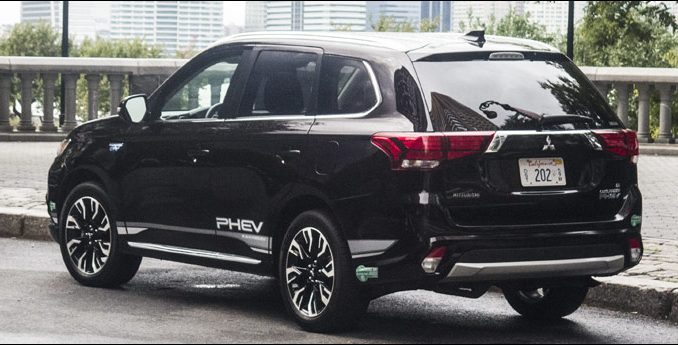
Mitsubishi, known by some for their economy cars and by others for their sports cars, has done a surprising amount of work in hybrid-electric propulsion — which may (along with a bid for the #1 sales title) be why Nissan-Renault ended up buying into the small Japanese automaker.
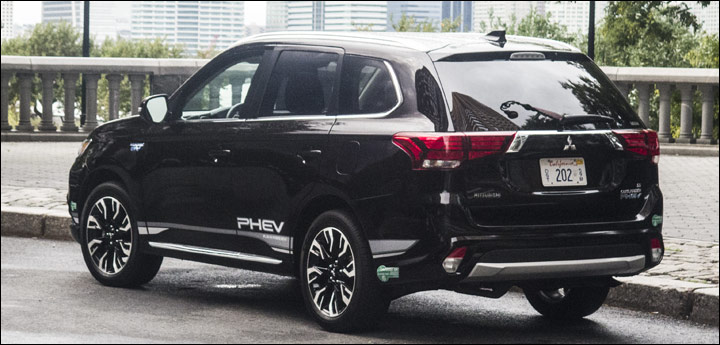
Some of Mitsubishi’s expertise may come from its relationship with advanced electronics firms — which bear the same name. The three-sorta-diamond-thing logo you see on Mitsu cars are also on computer chips and other digital goods — it’s the same group of companies, or at least it was until the Renault-Nissan deal.
Like many others, I’ve walked by the middle i-MiEV (hey, I just “got” the name) electric car at shows without giving it much thought. A quick look at the specs ruled it out as an item of interest, though it won at least one Pike’s Peak competition.
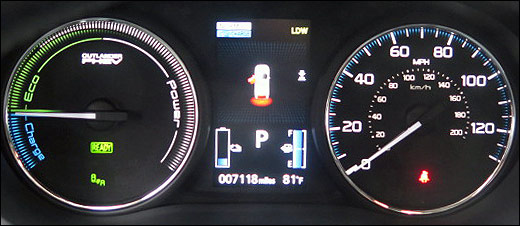
The Mitsubishi Outlander PHEV crossover is another story; it does 0-60 in just over 9 seconds, with room for four people and their cargo, with the requisite AWD system. The fuel economy is 74 mpg combined city/highway with a full battery, or 25 mpg on gasoline. (Amusingly, that’s actually worse than the gasoline-engine Outlander, which is rated at 26 combined). It costs $1.63 to drive 25 miles using electricity, and $2.87 using gasoline, according to EPA estimates. The cost is, with various discounts and tax credits, around $30,000, for a pretty well-equipped crossover ($34,595 list price, $40,295 fully equipped).
I’m not saying the Outlander PHEV is a superb performer, by the numbers, because, well, it isn’t. The Chrysler Pacifica PHEV, which is larger and also nicely equipped, does better, albeit for more money. The technology that goes into the powertrain is more impressive, especially since the chassis was launched back in 2014.
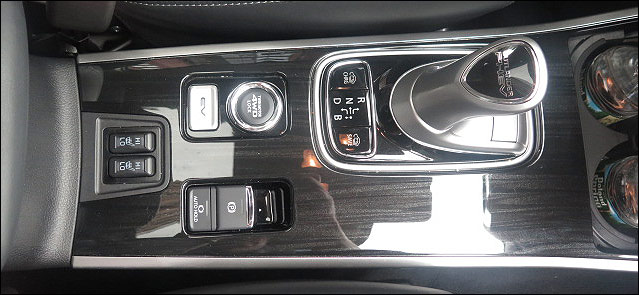
The world’s best selling AWD PHEV crossover (it’s new to the US, but was already sold in Europe and Asia) — not to slice segments thinly or anything — has both serial and parallel hybrid modes, and it switches automatically between them. In series mode, the engine charges the battery, and the electric motor provides all propulsion; in parallel mode, the engine and motor work together. Generally, serial hybrid is used for sudden acceleration, and parallel hybrid for long trips, e.g. highway cruising, beyond the pure-electric capability.
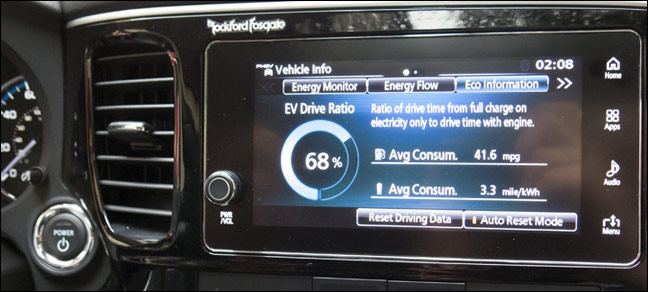
Not terrible for going through Manhattan on a weekday. My Dart Aero, rated at 28/39 mpg, dropped to around 12 mpg on a similar trip.
Unlike the Chrysler, you can control how it operates, choosing automatic, “prefer pure electric,” “save the battery for later,” or “please charge the battery.” (The Battery Save Mode can only be used when the battery falls below 90%). The idea here is that if you’re driving into, say, Manhattan, you can go into the city on gasoline, saving the battery, then go into pure-electric mode for crosstown traffic. If the battery is low on your trip into Manhattan, you can ask the system to charge it for you, and it’ll be fully charged in around forty minutes. You can also use battery-charge mode if you know you’ll be going up a steep hill, and will need extra power from the electric motor.
Paddle shifters let you choose between six different regenerative charging levels, which in itself is highly unusual — drivers don’t normally get a choice. (The paddles look and work the same as on Chrysler and Dodge cars with the eight-speed automatic.) If you go to level 0, (their name), you get barely any regenerative charging when you coast. Go to the highest level, and every time you lift the foot off your gas, it feels like the brakes are on, handy if you’re going down a very steep, sharp hill. The normal automatic level is 2, which feels natural for an automatic; level 3 is like having a car with a manual transmission, in gear.
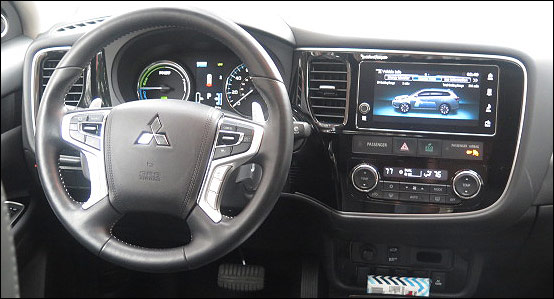
The system was used in Mitsubishi’s successful Baja 500 car; it has no driveshaft or transfer case, but puts an independent electric motor into each axle. The 2-liter gasoline engine (117 hp, 137 lb-ft) works via CVT or by powering the electrics, locomotive-style. The 300-volt lithium-ion battery holds 12 kW of power, and can be charged in three and a half hours on 240V or up to 80% in 25 minutes with a fast charger. Towing capability — something lacking in many PHEVs — is 1,500 pounds.
Total range on battery is 22 miles, which is more than the average American’s commute; the total driving range, including gasoline, is 310 miles. All wheel drive comes from having motors in each axle, and evolved from the systems in the high-performance Lancer Evolution and off-road Montero. The 60 kW front motor is a lighter, newer version of the one in the i-MiEV, placed on the left side of the gasoline engine; the rear motor, also 60 kW, is under the cargo area subfloor. Unlike, say, the Jeep Cherokee, the Outlander lets you simulate a locking center differential; the 4WD lock button creates a 50/50 power balance.
As you might expect from a car with such a large battery, there are standard AC outlets, allowing up to 1,500 watts of power from the rear seat and cargo area.
Safety features include blind spot warning, rear cross path alert, forward collision mitigation, lane departure warning, automatic high beams, adaptive cruise, and a nifty multi-view camera system which you might have to learn a bit to use.
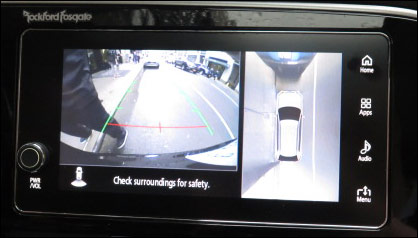
The system can also be controlled from a smartphone; the owner can set a charging schedule, turn the charging timer on or off, control heating, and defrosting, check the status of various systems, turn the lights on or off, and such.
It’s an impressive display of technology, and one can only imagine what they could have done with a completely new vehicle. (Presumably, you won’t have to imagine it at all, in a little while.) In the meantime, the Outlander PHEV is a good deal, especially for city dwellers and those with relatively short commutes, who can use it entirely as an EV. It’s priced quite well, given the gadgets and gizmos; the ride is a bit too far on the firm side, but the seats are comfortable, and there are fewer compromises than you might expect.

David Zatz has been writing about cars and trucks since the early 1990s, including books on the Dodge Viper, classic Jeeps, and Chrysler minivans. He also writes on organizational development and business at toolpack.com and covers Mac statistics software at macstats.org. David has been quoted by the New York Times, the Daily Telegraph, the Detroit News, and USA Today.

Leave a Reply